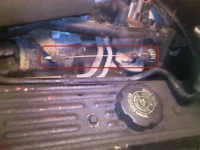(insert name here)
Member
- Joined
- Nov 30, 2014
- Messages
- 35
- Reaction score
- 0
- Points
- 6
I started to type a really long story for the post, and realized that would probably just be tedious to anyone trying to read it, so I'm changing it to a basic facts post instead (still fairly long):
- My '93 Roadmaster recently started having issues shifting up out of first and second gear (first especially).
- Once up to third gear, things seem to work as normal.
- The normal engine speed on my Roadmaster prior to my problem was between 800 and 1200 RPMs. Now it often gets as high as 1600 to almost 3000 RPMs (I realize many other cars operate in the 1500 to 2500 RPM range on a regular basis, but I've driven this Roadmaster enough to know that's not how it worked before).
- I'm not a lead foot, so it's not like the engine is revving so high because I'm accelerating like a madman all the time.
- The car is not low on transmission fluid, and the transmission isn't slipping because it will still take off normally if I give it a good amount of gas.
- If the car refuses to shift up and I punch the gas for a split second, this seems to sometimes make the transmission jump up into the correct gear.
- Prior to this, two things of potential significance happened:
- We had a snowstorm with about a foot of snow in the streets. On multiple occasions, I had to floor it for extended periods of time to be able to build up momentum and push through this snow from a dead stop (and yes, I know how to drive in the snow; these were odd conditions where the only thing even slightly effective was going full throttle). I also had to rock the car at one point (which I hate doing because it involves rapidly shifting between reverse and first gear).
- Immediately the next day (i.e., before I had a chance to drive the car on plowed roads to notice any potential damage from the snowy conditions) I unintentionally overfilled the transmission by more than an inch on the dipstick and then drove about 130 miles on the highway (the transmission fluid has leaked since I got the car, so I regularly check it and add to it, especially before long trips). I noticed a slight problem shifting up on the way out of town, but once I hit the highway I had no more issues until I arrived at my destination and started traveling at low speeds again, which subsequently resulted in the car shifting up far later than normal. I rechecked the fluid, and at this point saw it was overfilled. I drained the fluid to the normal level using the top coolant line into the radiator and noticed little improvement. When I took the 130 mile trip back home, I once again had no problems at highway speeds, and only started having issues again when I arrived back in my hometown and had to slow down.
- I took the car to a transmission shop for a free computer scan, and they told me the car's transmission had no computer and the only way they could diagnose things was to service it and charge me. I do my own mechanical work and don't like giving people money, so I took the car back home.
- The transmission does have a speed sensor on the tail end of it, but the above incident implied to me that data from that sensor is only used to tell the engine's computer things, and thus it cannot be the problem with the transmission.
- I'm currently in the process of changing the filter (which has turned into a huge ordeal instead of being what I thought would be an hour job), but have given up for the night. I'm posting this message now, so that if changing the filter doesn't help, I can see if anyone has any other directions to point me. I did notice several electrical wires running around inside after I got off the transmission pan, so I'm a bit confused about what these are for given that the transmission supposedly has no computer-controlled components.
- I have already opted not to do a full flush on the transmission (which I was initially going to do this morning) based on seeing many people say online that flushing an old transmission that's been running on the same gummed up fluid for years can actually throw everything out of whack and kill it even faster. The transmission fluid I've gotten out doesn't look ridiculously old, but I was unable to find any record of the transmission ever being serviced in the paperwork I got with the car, so I figured it was best to start simple and just change the filter. I guess it's also conceivable that the transmission's been "flushing" itself for quite some time by constantly leaking and needing to be refilled.
- Does anyone have suggestions on what the problem is if changing the filter doesn't fix it?
- Might it still be something electrical (even though I dismissed that thought after the transmission shop said there was no computer to diagnose) such as the speed sensor or maybe a solenoid?
- For the love of God, please tell me there's a trick to get at those two bolts on the pan hidden above the stupid cross-member bracket thing that covers them up and prevents you from being able to stick a wrench on them! I managed to get them off after much wasted time, improper tool use, and forearm pain; but now I'm dreading having to put them back on.






